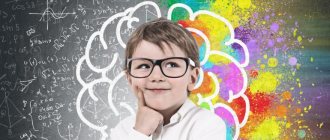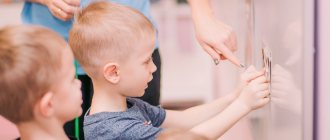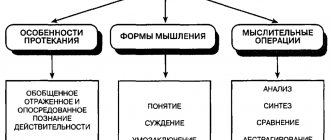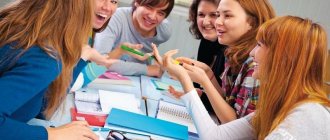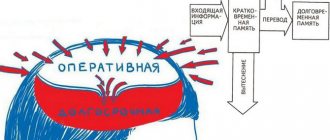Types of thinking
Thinking begins to form from birth, but for many this development stops for various reasons. It happens that having reached a certain level, it slows down or stops altogether. But if desired, this process can be accelerated or restarted.
There are the following types of thinking:
- logical;
- creative;
- figurative;
- visual;
- abstract (verbal-logical).
As a rule, each of us has several types of it, but only one is best. Today we’ll talk about the development of verbal and logical thinking.
What is this?
Verbal thinking (verbal-logical) “gave” man such concepts as love , happiness, conscience, honor - everything that is impossible to see.
At the same time, everyone puts their own meaning into these concepts, based on previously obtained sensory and visual experience, research and patterns. This type of thinking is constantly being formed, improving throughout life, just like other forms of thinking.
The essence of verbal-logical (abstract) thinking
Any thinking can be precise (when we understand exactly what we are thinking about) and abstract (generalized). In other words, a person examines the picture not in detail, but in general terms. He can guess, assume, summarize information and draw appropriate conclusions.
The main characteristics of a person who thinks abstractly:
- easily evaluates and compares phenomena and objects that are completely different in characteristics and purpose;
- classifies and divides knowledge;
- continuously analyzes what is happening;
- distinguishes particular events from the whole;
- extracts what is significant and cuts out unimportant details and events;
- classifies objects and phenomena according to certain criteria;
- finds common ground between the general and the particular.
It is worth noting that age does not in any way affect the ability to think. You can train both the thinking of a child and an adult. The effectiveness of such training also does not depend on age. There are simple and effective training methods.
Why do you need to develop logic?
How to develop thinking? Every person has it to one degree or another. But for a better understanding of reality and the ability to operate with it, logical thinking, developed at a fairly high level, is necessary. This can only be learned through training.
Creative thinking can be developed and negative thinking can be eliminated. The brain is trained no less than the muscles, perhaps more. By constantly training thinking and memory, a person can develop throughout his life, methodically improving his performance. The development of intellectual abilities is a guarantee of effective self-improvement.
Thanks to the ability to think logically, a person acquires the ability to think creatively, because a completely different understanding of reality opens up, which gives many advantages.
It is commonly believed that creative thinking is opposed to logic and reason, but this is a false statement. Creative perception of reality is fundamental to creativity. This does not at all mean the need for negative thinking, which is characterized by focusing exclusively on the bad. On the contrary, it allows you to train your brain, clear it of stereotypes and interfering attitudes, and look at everything from the outside. This is how perfect horizons open up. As a result, the ability to solve problems in a non-standard way, to find previously impossible ways.
TOP 10 exercises that develop a child’s thinking
- Find as many objects as possible that are similar to the invented word. For example, you can choose those that have the same shape. To the “ground” we select “ball”, “apple”, “balloon”.
- List the objects that share some property. We need to name it. Examples: cup, saucer, pan - dishes; apple, apricot, pear - fruits; hat, shirt, shorts – clothes.
- From the list of words it is necessary to exclude the one that does not fit all the others. Apple, soup, pencil, bread. (Bread)
- Come up with a coherent sentence with arbitrary three words. For example, sun, pineapple, shopping. Today we have an unusual purchase - a pineapple that looks like the sun. We see that words do not change by case. This is the best answer. If it becomes difficult, you can incline the words or reduce their number.
- We have a series of words, all of which except one begin or end with the same letter. You need to find this word.
- Come up with as many objects as possible of the same color or the same shape. A modified task will be the selection of objects that have a similar taste, smell, etc.
- Guess the hidden word based on its signs. Cold, fluffy, winter. (Snow)
- Take an excerpt from any story. Come up with a beginning and a logical conclusion to it in detail.
- A few simple phrases: “cold wind”, “delicious dinner”, “business coat”, “huge interest”, read first in the correct order, and then in the reverse order.
- Find as many differences as possible between an airplane and a ship, an apple and a potato, etc.
When working with your child, remember that the formation of thinking begins at an early age. Make it a habit to regularly ask your child some of the above problems. Very soon you will be able to notice that some exercises delight your baby. Present it all in a playful way. For the child it will be both exciting and useful at the same time.
Games and exercises for memory development
Memory Game
Age: from 3 years
This is one of the most famous and favorite memory development games for children. Otherwise it is called “Find a Pair”. The game is a set of paired pictures with the same designs: for the little ones it is usually 12 cards (6 pairs), for older children the number increases. The idea is simple - find identical pairs from the total number of cards lying face down. If the cards match, the player takes them, if not, returns them back.
There are a lot of both paper memories and online games. Ikyusha also loves such exercises, try to find the pairs faster than him?
Game "What's gone?"
Age: from 3 years
An excellent game for developing visual memory and increasing attention span, which does not require additional materials.
Place 4-5 toys or small objects in front of your child for a minute and ask him to turn away. Then remove one item and ask what is missing? The kid must name what is missing. If the game is boring, diversify it by adding a new item.
The task must be gradually made more difficult, increasing both the total number of toys and those that we add or remove. Focus on the child’s age: for example, by the age of 6-7 years, a child can easily remember up to 10 objects.
Choose a pattern
Exercise “Fold the pattern”
Age: from 4 years
Make a pattern or lay out a drawing from simple geometric shapes (can be cut out of cardboard) or construction set parts and ask your child to remember it. Then the child needs to turn away for a while, and during this time you change the location of one figure or part. The baby’s task is to find changes and restore the pattern.
At first you can start with 3-4 parts, gradually increasing their number. If the child can do it easily, remove several parts or all at once, asking him to reassemble the pattern.
This exercise develops memory and imagination, increases the volume and concentration of attention.
Choose a pattern
Game “Remarkables”
Age: from 5 years.
Ask your child to close his eyes and list everything he saw in the room, indoors, outside. The more small details he remembers, the better! Ask your child leading questions if it is still difficult for him to answer. For example, how many children play in the sandbox? Did the cashier at the store have long or short hair? How many cups were there on the table?
Game "Locomotive"
Age: 4-7 years
This is a very fun and entertaining game for a small group of children. The idea is simple - the first child names any object, the next player repeats the word and names his own. The third child repeats what the first two said and adds himself, and so on.
“Locomotive” helps to increase memory capacity, develop auditory perception and voluntary attention. You can also consolidate the material in this way, for example, by naming only fruits, vegetables, trees, flowers.
TOP 10 exercises that develop adult thinking
- Solve crosswords and charades.
- Say words and whole sentences in reverse order.
- From the selected passage of text, come up with a piece that is opposite in meaning to the original one.
- Come up with as many characteristics as possible for the chosen words.
- Team exercise: a member of one team performs an action, and the other team looks for the reason for it. For example, someone drank water, the answer to this action would be “the appearance of thirst.”
- Develop your left hand if you are right-handed, and your right hand if you are left-handed. You can start with the simplest thing - holding a spoon or fork.
- Team exercise. Members of one team use random words to describe some children's poem or cartoon that is familiar to everyone. In this case, the names of people and names of animals must be skipped. The opposing team must guess what verse or song is being talked about.
- Based on the listed properties, color, shape, smell, area of use, you need to guess what kind of item we are talking about.
- Without words, you need to show the object, and the participants in the game must guess what it is about.
- You need to come up with the first word - the beginning of an associative series, and after that select as many associations for it as possible. For example, white - snow - winter - cold - Christmas, etc.
These exercises have different levels of difficulty. If you feel that a task is beyond your strength, start with an easier one. The more often and harder you practice, the more developed your thinking will be. In addition, many of the team activities listed above can be a good leisure option with friends and family.
Periodic training of attention and associative thinking has the best effect on the development of fantasy and imagination, and also makes it possible to improve memory, creative activity in any area and, in general, significantly improve the quality of life.
Synopsis of the psychological lesson “Development of verbal-conceptual thinking”, grades 3-4
Psychological lesson in elementary school.
Abstract Goal: creating a favorable atmosphere for self-disclosure of participants, development of verbal-conceptual thinking, increasing the general level of ideas about the world around us, developing vocabulary, developing the ability to establish meaningful logical connections, developing written speech, bringing joy to oneself and others. 1. Information The psychologist informs students that during the classes they will receive knowledge that is applicable in everyday life, they will competently express and formalize the content of their thoughts orally and in writing. Today in class, after completing a series of exercises, they will increase their vocabulary, level of ideas about the world around them, and also learn to establish meaningful logical connections. 2. Introductory part. Exercise - warm-up “Crystal ball”. Goal
: creating a favorable atmosphere for self-development.
Progress.
The exercise is carried out in a circle.
The presenter takes out a crystal ball from the “magic” box, then asks the children, passing the ball around, to tell what good happened to them today. 3. Main part. 1. Exercise “Arrange the words” (from a particular concept through an intermediate concept to a general concept)” Goal:
development of verbal-conceptual thinking, increasing the general level of ideas about the world around us.
Progress.
The psychologist explains that, in addition to particular and general concepts, there are words denoting an intermediate degree of generality, i.e.
if they are compared with particular concepts, then they will be more general in relation to them, and when compared with general concepts they will be more particular. For example, the concept “dog” is more general in relation to the particular concept “poodle” and particular in relation to the more general concept “animal”. Then the teacher shows three word cards. Students must arrange them from left to right so that the concept on the leftmost is particular, the one on the right is the most general, and in the middle is intermediate in generality, i.e. particular in relation to the right concept and general in relation to the left concept. Words to present: Mineral - fuel - oil. Shower - precipitation - rain. Forest plant - tree - oak. Reservoir - lake - Baikal. Edible mushroom ~ mushroom - oil can. A cow is an animal - a domestic animal. Reservoir - river - Volga. Woodpecker is a forest bird. Meadow grass ~ grass - clover. Body of water - Atlantic Ocean - ocean. (Particular concepts are in bold, intermediate ones in italics.) 2. Exercise “Make new words by changing one letter in the word.” Goal
: development of vocabulary Progress
Students
are offered the words: role, mouse, village, bow, code, hole, hand, grove.
Sample answers:
role - moth, salt, pain, zero, steering wheel;
mouse - bear, fly, midge, tower, crumpet; village - body, business, lard, village, hay, solo; bow - ray, meadow, face, hatch, varnish, branch, beech, beetle; code – com, count, cat, kon, year, genus, move, ked; nora – note, leg, mountain, time, bark, Nyura; hand - river, pike, beech, flour; night – zero, daughter; grove - dew, rose, horns, robe, mug, company, Roma. 3. Exercise “Find the error.” Goal:
development of the ability to establish semantic logical connections, development of written speech.
Progress
Students are given suggestions in which they need to correct mistakes: 1. In winter, apple trees bloom in the garden.
2. Below them lay an icy desert. 3. The boy broke the ball with glass. 4. After the mushrooms there will be rains. 5. In spring, the meadows flooded the river. 6. The snow was covered with a lush forest. 3. Final part. Exercise “Let’s give each other a smile.” Goal:
bringing joy to yourself and others.
Children stand in a circle. They gently hold hands and smile at each other, thereby giving their comrades a good mood. 4. Reflection. Purpose
: summing up the lesson, discussing the results of joint activities.
— Questions from the psychologist: — What did you do in class? — What did you learn during the lesson? — What was easy and what caused difficulties? Literature: 1. Lokalova, N.P. 120 lessons on the psychological development of younger schoolchildren (psychological program for the development of the cognitive sphere of students in grades I–IV). Part 2. Materials for lessons in psychological development / N.P. Lokalova. - - 5th ed., erased. – M.: “Os-89”, 2011. 2. Akimova, M.K., Correctional and developmental exercises for students in grades 3-5 / Akimova, V.T. Kozlova. - M., 1993. 3. Tikhomirova, L.F. Logics. Children 7-10 years old/L.F. Tikhomirov. - Yaroslavl: Development Academy: Academy Holding, 2001.
We recommend watching:
Synopsis of a psychological training session for younger schoolchildren Plan - synopsis of an art - therapeutic lesson for younger schoolchildren Synopsis of an open lesson by a teacher-psychologist Master class of a teacher-psychologist for younger schoolchildren
Similar articles:
Lesson for younger schoolchildren “Cultivating willpower”
Advantages of a person with developed abstract thinking
As a rule, these people have abilities in sciences such as mathematics, physics, and astronomy. It is easy for them to study in schools and universities. They can:
- easy to remember large amounts of information;
- abstract and simulate non-standard situations;
- even in confusing situations, make non-standard decisions;
- quickly adapt to unfamiliar conditions.
Verbal-logical thinking allows people who have developed it to build associative series associated with the definitions they hear.
The main positive features of such thinking are unlimited space and time. Those. This type of generalized thinking gives a person unlimited possibilities.
With the right approach and regular training, you can achieve your goals and optimal performance in almost any area:
- the science;
- creation;
- intellectual sports;
- career;
- training, etc.
Who needs to develop logic?
Logical thinking is necessary for any person, regardless of his goals. After all, with flexible thinking, each of us can:
- find the optimally beneficial solution to a problem situation;
- always be several steps ahead of enemies or competitors, calculating their possible actions;
- choose the right way to achieve your goal;
- express your thoughts in a form understandable to everyone;
- It’s quite easy to find arguments to sway opponents in your direction;
- avoid making professional and life mistakes;
- deal with sophistry and demagoguery;
- be able to quickly formulate an answer to the question posed, avoiding blurting out the first thought that comes to mind, which can cause great harm later;
- clearly see manipulations on the part of other people, do not become a victim of their deception;
- be aware of mistakes made by other people or yourself, and quickly and easily eliminate them.
Visual-figurative thinking and its training
With the help of visual-figurative thinking, a person can solve a given problem visually, without interacting with surrounding objects.
For example, when you need to imagine what a room will look like after rearranging the furniture. A person can mentally rearrange objects to get an idea of how the room will look.
This type of thinking develops with the help of the right hemisphere of the brain. Important: do not confuse visual-figurative thinking with imagination. Imagination is imaginary actions and objects, not real ones.
Several exercises to train this type of thinking. Suitable for both children and adults:
- Try to reproduce in your thoughts the details of clothing, facial features and hairstyles of those people you saw today
- Think about how you can describe the words “beauty”, “success”, “wealth” using only two nouns, one adverb, three verbs and adjectives.
- Try to reproduce some event of today: what you talked about with your interlocutor, what emotions you felt, what the taste of the dish you ate was, how many people were around you, how you stood or sat.
If you want to develop visual-figurative thinking playfully and quickly -.
